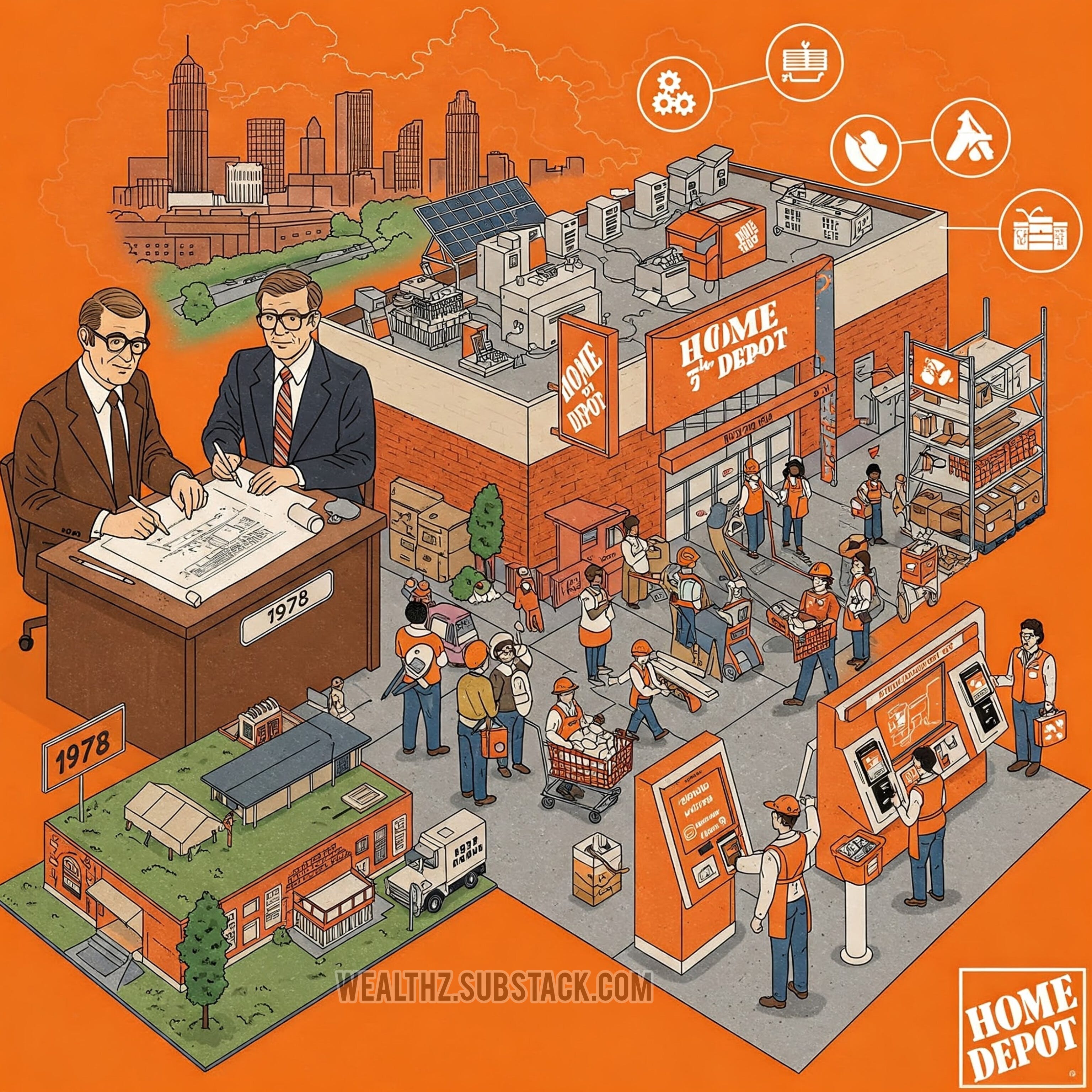Founding Background (Late 1970s)
The late 1970s in America was a period of economic challenge, marked by inflation, high interest rates, and a rapidly shifting retail landscape. Amid this, two men—Bernard Marcus and Arthur Blank—found themselves unexpectedly unemployed after being fired from Handy Dan, a regional home improvement chain. Rather than view their dismissal as a setback, they saw an opportunity. Drawing from their experience in retail and driven by a bold vision, they imagined a new kind of home improvement store—massive in size, customer-friendly, and low in price. This idea would eventually revolutionize the industry.
Founding of Home Depot (1978–1979)
In 1978, Marcus and Blank joined forces with Ron Brill and Pat Farrah, a fellow industry expert and founder of the Homeco chain. Their dream required capital, which they secured thanks to the efforts of Ken Langone, an investment banker who believed deeply in their idea. Langone successfully raised $2 million in seed capital from a group of investors.
In 1979, the first two Home Depot stores opened in Atlanta, Georgia. These stores were unlike anything the American consumer had seen before—each more than 60,000 square feet, they offered tens of thousands of products under one roof at discounted prices. From the beginning, Home Depot’s mission was to empower the DIY (Do-It-Yourself) customer with not just affordable products, but also education and support.
Early Operations and Business Model
Home Depot’s early success stemmed from its clear value proposition: low prices, wide selection, and exceptional service. Associates weren’t just retail employees—they were trained experts, many with trade experience. The stores themselves were deliberately designed to look like warehouses, reinforcing the notion of cost-efficiency. Customers could find plumbing supplies, lumber, power tools, and gardening equipment all in one place.
Crucially, Marcus and Blank focused on company culture, embedding values of respect, integrity, and entrepreneurial spirit. Employees were incentivized through stock options and career growth, building loyalty and morale.
Growth and Going Public (1980s)
As word spread and customer demand surged, Home Depot expanded rapidly throughout the Southern U.S. In 1981, just two years after opening their doors, Home Depot went public on the NASDAQ under the ticker HD, raising additional capital to fund growth.
The 1980s were a period of aggressive expansion. Home Depot opened dozens of stores across new markets, refining its model and outpacing competitors. The company’s economies of scale enabled it to negotiate better prices with suppliers, further lowering costs for customers. By the end of the decade, Home Depot had become a household name in home improvement.
Market Domination and Innovation (1990s)
By the early 1990s, Home Depot had become the largest home improvement retailer in the U.S., eclipsing rivals like Lowe’s and Ace Hardware. Its success was driven by constant innovation: it introduced tool rental programs, expanded into services for professional contractors (known as Pro customers), and launched Expo Design Centers to appeal to upscale clientele.
International growth also began in earnest. Home Depot entered the Canadian market in 1994 and began exploring expansion into Latin America and China.
Sales and profits soared during this decade, with the company achieving Fortune 500 status and crossing revenue milestones few thought possible at its inception.
Challenges and Strategic Shifts (Early 2000s)
The early 2000s marked a period of turbulence for Home Depot. In 2000, Bob Nardelli, a GE executive with no retail experience, was appointed CEO. Nardelli implemented a centralized and metrics-driven management style, which clashed with the company’s customer-first culture.
Under his leadership, the company emphasized cost-cutting, efficiency, and supply chain optimization, often at the expense of store-level autonomy and employee morale. While financial metrics improved initially, customer satisfaction declined, and the stock stagnated.
Meanwhile, Home Depot’s attempt to enter wholesale distribution through its acquisition of HD Supply proved cumbersome and distracted leadership from its core retail business.
Recovery and Re-Focus (2007–2010)
After Nardelli's departure in 2007, Frank Blake took over as CEO and began steering the company back to its roots. Blake decentralized management, sold off HD Supply, and reinvested in employee training, store upgrades, and customer experience.
This strategic realignment reinvigorated the brand. By prioritizing its frontline employees and core retail mission, Home Depot regained its competitive edge. The company’s performance rebounded sharply, and it regained the trust of both customers and investors.
Digital Transformation and Continued Growth (2010s)
With the rise of e-commerce in the 2010s, Home Depot embraced digital transformation. It launched a robust online shopping platform and integrated it with physical stores through an omnichannel strategy. Customers could now order online and pick up in-store or have items delivered directly.
Investments in logistics included automated distribution centers, enhanced inventory management, and same-day delivery capabilities. The company also focused more on Pro customers, developing tailored services and credit programs for contractors and businesses.
By 2019, Home Depot had solidified its position not just as a retail giant, but as a technologically advanced and operationally sophisticated organization.
Home Depot in the COVID-19 Era and Beyond (2020s)
The COVID-19 pandemic in 2020 brought new challenges and opportunities. As people spent more time at home, DIY projects and home renovations surged. Home Depot quickly adapted, implementing safety protocols, expanding curbside pickup, and increasing its online capacity.
The company recorded record-breaking revenue growth in 2020 and 2021. Its ability to deliver under crisis highlighted the strength of its supply chain and digital infrastructure. Home Depot also committed to expanding its diversity and inclusion initiatives and supporting local communities through grants and disaster relief.
Present-Day Operations and Global Reach
As of 2025, Home Depot operates over 2,300 stores across the U.S., Canada, and Mexico, employing more than 500,000 associates. The company generates over $150 billion in annual revenue and remains the world’s largest home improvement retailer.
Join us: ➡️ Instagram | Telegram | X ⬅️




